Project Pipeline – County Durham & Tees Valley (2024)
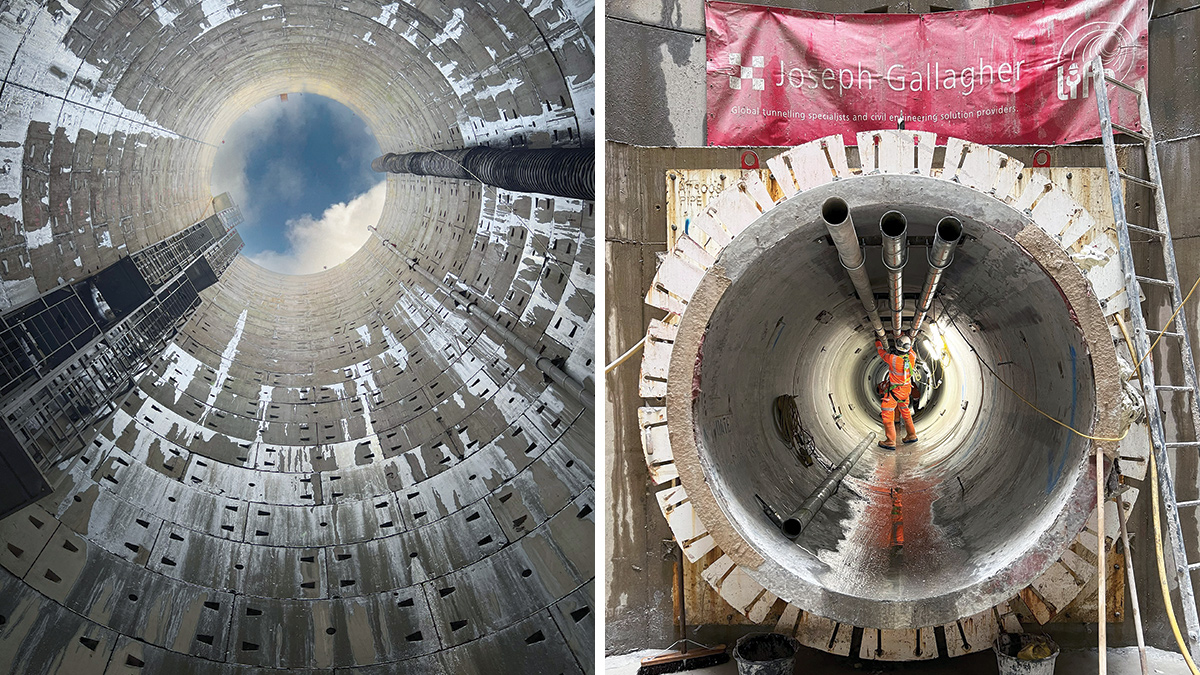
(left) Tunnel shaft construction and (right) tunnel construction - Courtesy of Farrans Construction
Northumbrian Water’s County Durham and Tees Valley Pipeline, which is approximately 57km in length, is designed to improve water quality and increase resilience and operability within the Tees Network. The pipeline will replace existing potable water mains across the North East of England, some of which are more than 150 years old. The new pipeline will connect Lartington Water Treatment Works (WTW) to service reservoirs at Whorley Hill and Shildon, and the route includes a major crossing of the River Tees, 12m below the riverbed. Upon its completion, the pipeline will serve approximately 200,000 customers and link strategic assets serving Barnard Castle, Darlington, and Teesside, improving overall system resilience. Construction began in November 2023 and the project is currently progressing well on site.
Cross country pipeline installation
The full route of the steel welded pipeline (Phases 1 & 2) includes crossings of the A1 motorway, three river crossings and two railway crossings. Farrans Construction is contracted to deliver Phase 1 of the project, the pipeline from Lartington to Shildon Service Reservoir, via Whorley Hill Service Reservoir. The chosen pipe material is robustly coated thin-walled steel, with individual pipe lengths of varying sizes (14m maximum) and generally 800mm in diameter. The Phase 1 pipeline is approximately 34km in length, including a section of twin 800mm diameter pipe, with one of the sections forming the starting point for Phase 2.
Shafts & tunnel at River Tees
Various options were explored to determine the most suitable method of the crossing of the River Tees, near Cotherstone Village, Barnard Castle, including pipe bridges and open cut trenches in the riverbed. However, there were several constraints that limited the viability of these options, including significant aquatic life disturbance and differing riverbank heights. The chosen option for the crossing was the construction of a tunnel under the river between two access shafts. The eastern shaft is approximately 46m deep and 7.5m diameter, whilst the western shaft is approximately 32m deep and 8m diameter, with the difference in shaft depth due to the rising topography of the eastern bank of the river. Each shaft has a 221 tonne reinforced concrete base.
Farrans Construction appointed Joseph Gallagher Ltd, an experienced specialist shaft and tunnelling contractor, to construct the river crossing under a sub-contract arrangement.
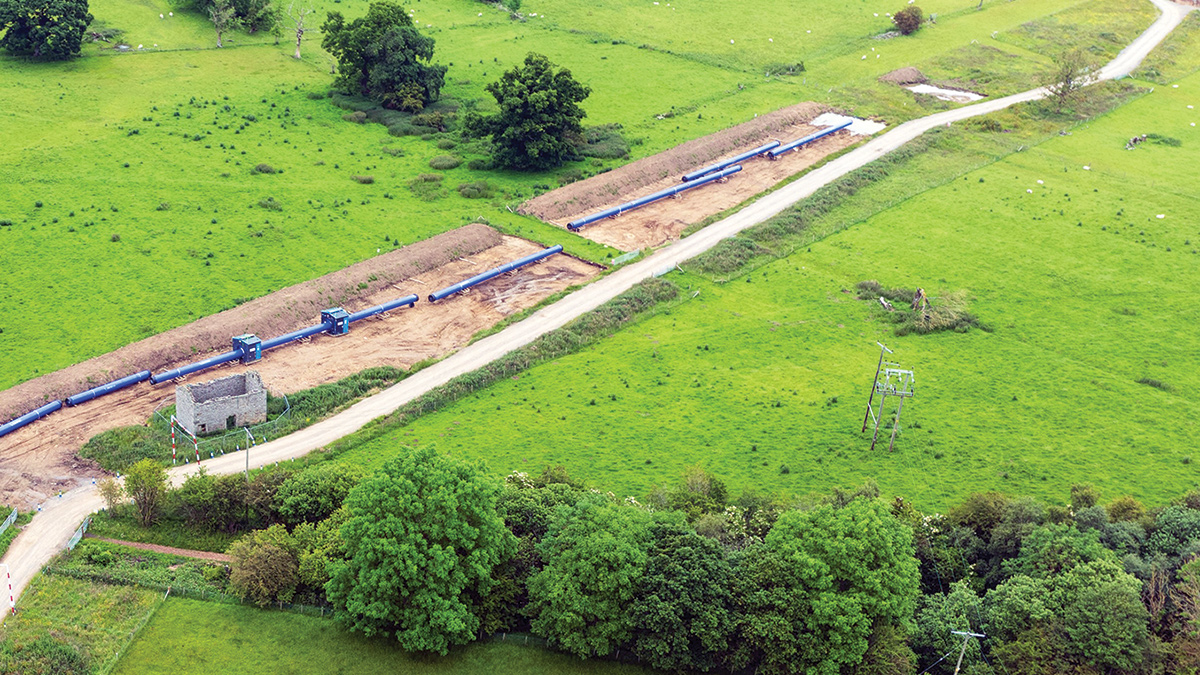
Pipe laying – Courtesy of Farrans Construction
Project Pipeline – County Durham & Tees Valley: Supply chain – key participants
- NWL designer – pipeline, tunnels & EIA: Mott MacDonald
- NWL designer – pipeline & connections: Stantec UK
- Design & construction: Farrans Construction
- Lead design for Farrans: AtkinsRéalis
- Tunnel design & construction: Joseph Gallagher Ltd
- Planning consultants: Lichfields
- Land management consultant: Bell Ingram
- Land drainage design: Land Drainage Consultancy Ltd
- Drainage installation: DMJ Drainage Ltd
- Groundworks: GR Potter Contracts Ltd
- Archaeological surveys: ECUS Ltd
- Geotechnical surveys: Dunelm Geotechnical
- Seismic surveys: Rees Onshore Seismic Ltd
- Trial holes at strategic connections: Waitings Ltd
- Slide rail shoring: National Trench Safety UK
- De-vegetation of hedgerows: ATM Ltd
- Steel pipes: FT Pipeline Systems
- Pipeline welding: Environmental Fabrications Ltd
- Pipe laying & associated welding: Grant Plant Hire Ltd
- Weld testing: Responsive Engineering
- Pipe fittings: George Green (Keighley) Ltd
- Pipe fittings: APP Fusion Ltd
- Pipe fittings: Franklyn Yates Engineering Ltd
- Pumps: Pioneer Pump Solutions
- Underpressure connections: UTS Engineering Ltd
- Shaft segments: Macrete (Ireland) Ltd
- Tunnel precast pipes: FP McCann
- Supply/install temporary bridge: Groundforce
- Silt fencing & flumes: JR Hind Ltd
Shaft & tunnel construction
To construct the shafts and tunnel, the first 2m of rock was excavated and 1m shaft segments bolted together to form a ring. The rings were surrounded with an in situ concrete ‘collar’ to provide structural integrity and ‘set’ the shafts. These rings were checked for plumbness, as this is critical to ensure the overall verticality of the shafts.
Excavation began with each subsequent precast concrete segment ring bolted to the underside of the one above, known as underpinning. To provide structural support, the rings were then back grouted through holes in the segments. This process was repeated with each new metre of rock that was broken, installing the next ring of concrete segments until the required depth was reached. The excavators and mechanical breakers used were relatively small for the hardness of the ground and the excavation depth, due to the constricted dimensions of the two shafts. The excavation process began in June 2023 and was completed in March 2024.
Once the shaft construction was complete, the bases were poured, followed by installation of the 2.24m diameter tunnel boring machine (TBM). The TBM system has a hydraulic jack that pushes it forward through the ground as it excavates the rock strata. The TBM was launched on rails from the east drive shaft. Following the excavation of the rock, the hydraulic jacks were retracted and a 2.5m section of precast reinforced concrete pipe was lowered onto the launch railing at the bottom of the shaft using a 70 tonne crane. The hydraulic jack re-engaged to push the new length of pipe behind the previous one and continue pushing the pipe and TBM forward. The tunnel is 220m long, which required 88 (No.) 2.5m long pipes segments.
The ground material, that consisted of abrasive sandstone and other materials such as quartz, caused significant wear on the cutter heads and pumps of the TBM. This slowed the excavation process significantly, but continuous work by Joseph Gallagher Ltd meant that an average of four pipe sections, or 10m of earth, were still excavated each day.
The concrete tunnel acts as a sleeve for the water pipes that will transfer the water supply under the river. Two parallel pipes were used to provide water supply security in case one should fail, and ductile iron was selected as the pipe material to provide additional strength and resilience. Due to the constricted diameter of the shafts, the pipes were lowered down in 5.5m sections, with each section of the pipe being joined to the next as they were fed into the tunnel. Spider supports were used to locate the pipes which were winched through the tunnel from the east to the west shaft. The spider supports, which were used as spacers, were clamped to the pipes at regular intervals and hold the pipes steady as they are pulled through the tunnel. Once the pipes were completed and tested, they were sealed, and grout was pumped in to fill the remaining void space.
Once all piping works are complete and the pipes connected to the cross-country pipeline, the shafts will be backfilled with sand to make future excavation easier should it be required. Approximately 3,500 tonnes of sand will be needed for the eastern shaft and 2,500 tonnes for the western shaft.
Management of ingress water
During construction of the shafts and tunnel, the hydrogeology of the area and consequent water ingress made the excavation technically difficult. During excavation, there was up to 45 litres/second water ingress in the western shaft; the wettest of the two shafts. To manage this, the water is continually pumped out into a lagoon system located 50m away. The water is then processed in lamella clarifying units, which remove fine sediments, to ensure the water meets the required environmental standards to allow it to be pumped into the River Tees. This was an extensive water management operation, conducted under a permit issued by the Environment Agency, ensuring all activities complied with regulatory requirements and environmental protection standards.
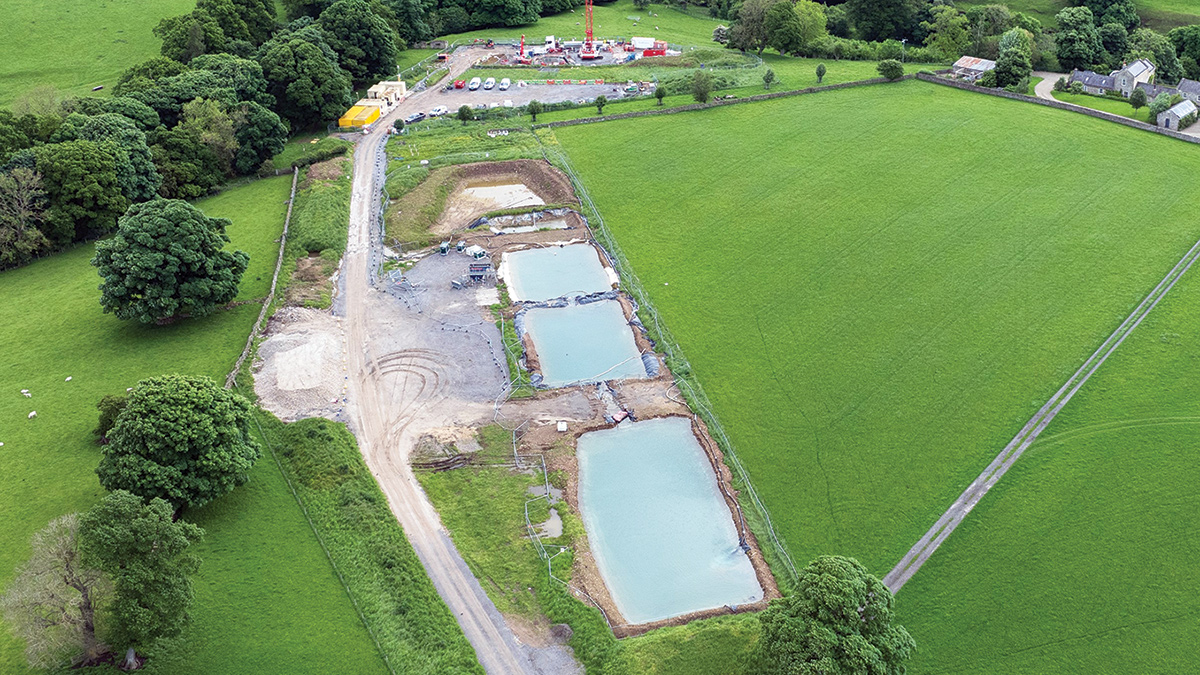
Water processing lagoons – Courtesy of Farrans Construction
The water management issues continued after the shafts had been excavated, and it was decided that the western shaft would require a concrete plug to be inserted beneath the base slab to halt further water ingress. Consequently, the team had to excavate deeper than originally anticipated so that the plug would not interfere with the tunnel alignment. The plug, which is 2.7m thick and made of approximately 167m3 of concrete, was left to cure for seven days before the water was pumped and work began on the shaft’s structural base. A plug was not required for the eastern shaft.
Environmental constraints
There have been numerous environmental constraints that have had to be considered and mitigated during the project. A prominent issue facing the construction activities is compaction of excavated soil leading to soil degradation. When soil is compacted, the pore spaces within the soil are reduced, leading to poor soil structure and the erosion of the soil surface layer. To mitigate against this, the topsoil is stripped, stored, and only reinstated when in a suitable, friable condition. Low ground pressure tracked vehicles are also used on the site and traffic restricted prior to topsoil stripping. The topsoil and subsoil are then segregated and stored according to DEFRA codes of good practice.
Construction activities within freshwater environments can pose a significant threat to aquatic life through the release of pollutants, including silt and sediments. Fluming was therefore implemented in several local watercourses to minimise pollution and sedimentation by isolating construction areas and diverting the natural flow of water through temporary piping.
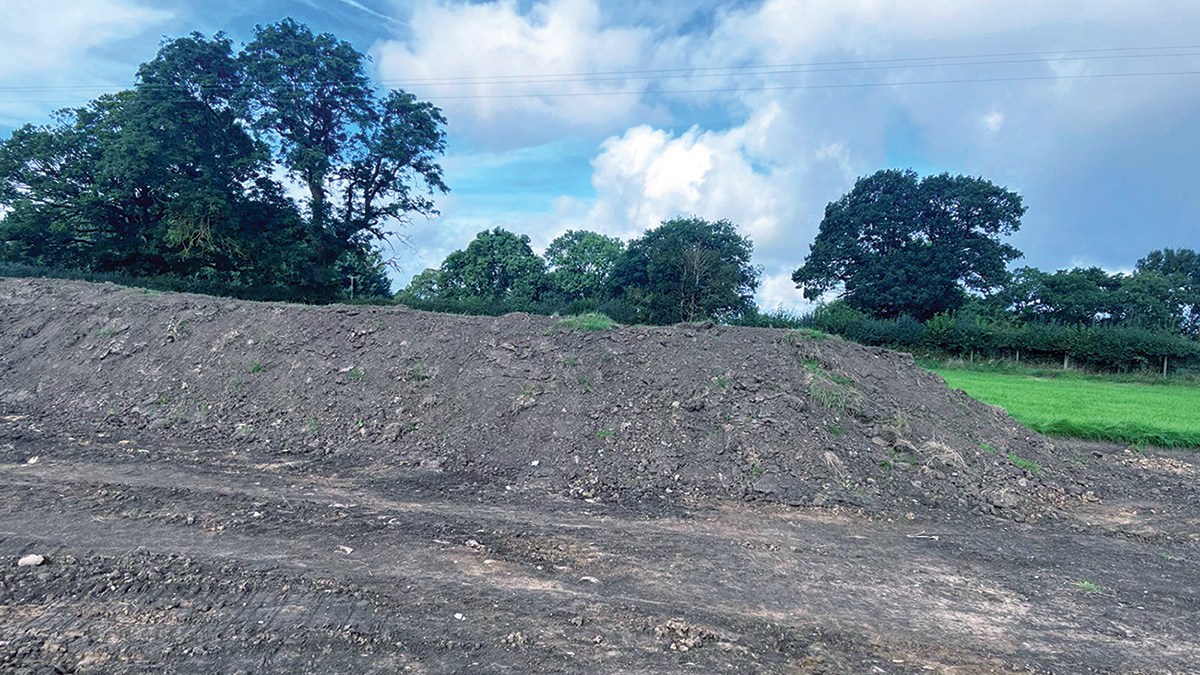
Topsoil bund at Lartington – Courtesy of Farrans Construction
Before fluming was implemented on site, several fish species, all of which are sensitive to almost all types of anthropogenic disturbances, had to be captured and safely relocated. Electrofishing was used to temporarily stun the fish so that they could be collected and moved to a safe location, ensuring the protection of several important species including salmon and trout. The combination of flumes and electrofishing minimised the disruption to the ecosystem, whilst regular monitoring ensured the flume remained effective, preventing leaks and blockages, and allowing for the assessment of fish population health and diversity.
Ground nesting birds were also present at some locations along the pipeline site, including populations of lapwing and curlew; both of which are listed on the UK Red List of Birds of Conservation Concern. To minimise disturbance to these species and other protected species such as badgers, great-crested newts, bats and otters, work was suspended during the nesting/breeding season. In addition, any active nesting sites located near the site were protected, and local authorities such as Natural England and the Environment Agency, were consulted.
Social value & community engagement
Community and stakeholder engagement has been a crucial part of the project to date, with Farrans delivering several schemes in line with Northumbrian Water’s values. Farrans began the engagement process through a ‘Meet the Contractor’ event, held in a local parish hall with attending stakeholders including community groups, local schools and colleges, parish councils, local businesses, and residents. A digital Microsoft form was also sent out to capture the thoughts of those who could not attend the event.
Representatives from Northumbrian Water were also present, and the information gathered was used to identify key issues and concerns raised by the local community and how those issues could be tackled during the project.
To involve the local community, mark the beginning of the tunnelling process, and the arrival of the TBM, Farrans and Joseph Gallagher Ltd ran a competition to name the TBM. This was won by a local girl called Penelope who attended the event with her family, naming the TBM after herself as it was ‘strong, like her.’ Farrans and Joseph Gallagher also asked the community to nominate a local charity that would receive a £1000 donation to mark the project milestone. The Great North Air Ambulance received the most votes and attended the event on the day.
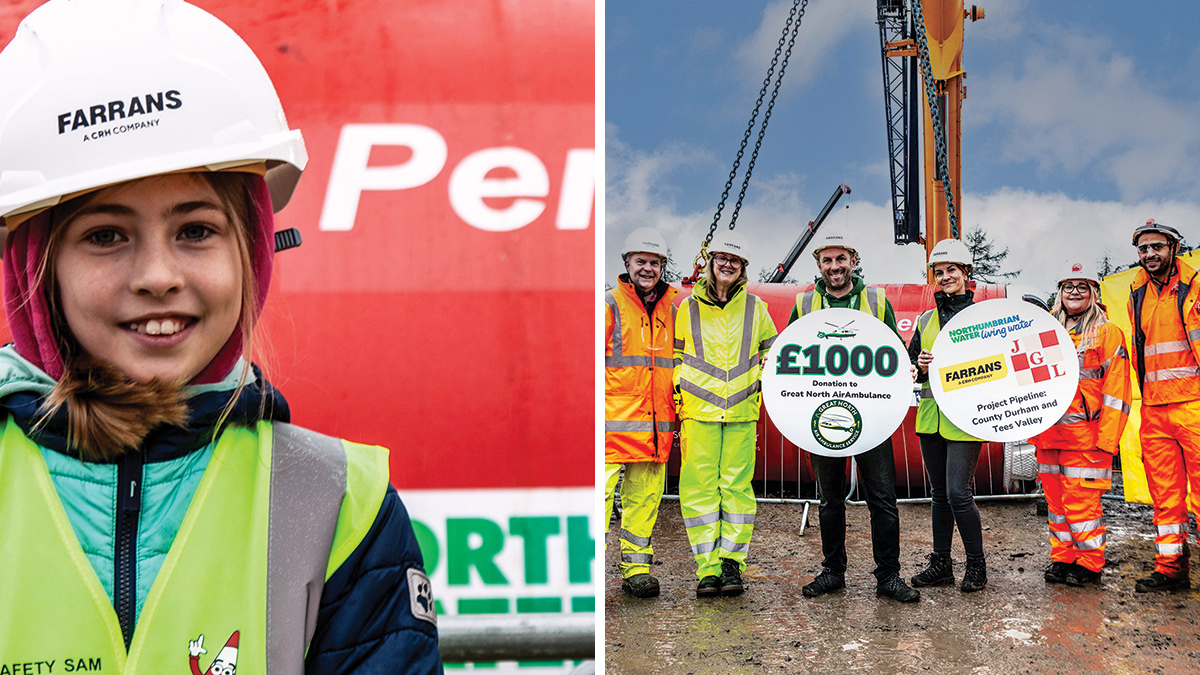
(left) Penelope named the TBM after herself and (right) £1000 donation to Great North Air Ambulance – Courtesy of Farrans Construction
Farrans are also involved in educational engagement by joining in with established local programs such as the ‘Start Small, Dream Big’ school initiative, run by the North East Local Enterprise Partnership. The scheme is a national DfE funded pilot aimed at raising aspirations, challenging stereotypes, and helping children connect with the world around them.
Farrans took part by running several STEM workshops, with local children taking part in exercises to design and build water filters, in the context of surviving a ‘Zombie Apocalypse’. In doing so, they learnt about the work Farrans is doing for Northumbrian Water in delivering the Tees Pipeline, as well as the importance of transferable skills and the diversity of roles within the construction and civil engineering sector.
Stakeholder engagement (farmers and landowners)
Northumbrian Water appointed a land agent to streamline the engagement of landowners and farmers along the pipeline route who would be impacted by the works. The land agent, Bell Ingram, conducted detailed conversations that began during pre-construction, and have continued throughout the project. This liaison has ensured that key stakeholders are kept fully informed of the progress of the works and any potential impacts it may have on them, including pre-construction investigation, access, and post-construction drainage designs.
Conclusion
Despite some of the technical challenges and ongoing poor weather conditions faced during construction, the project is progressing generally to programme. By July 2024 the Tees tunnel had been completed and approximately 20km of cross-country pipeline had been laid. Proactive stakeholder engagement has contributed significantly to the ongoing success of the project, with positive engagement with landowners and farmers being particularly noteworthy.
The project is on schedule to deliver water into service in early 2025, with reinstatement works to be completed by August 2025.
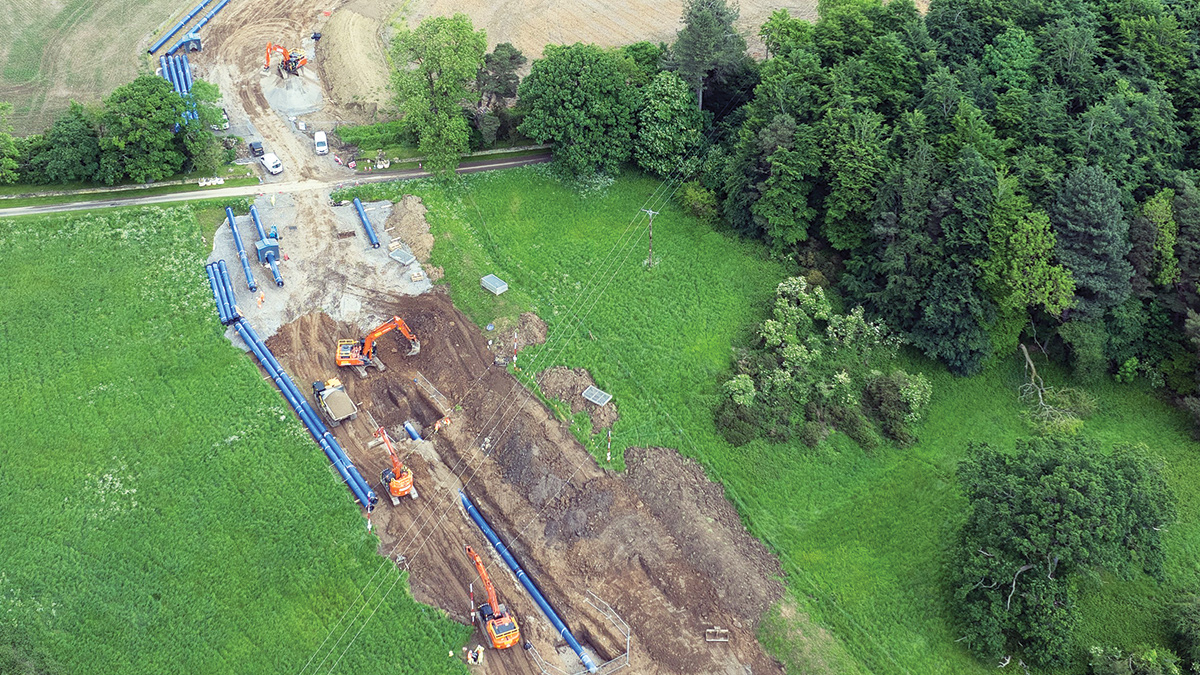
Cross country pipe laying operation - Courtesy of Farrans Construction













